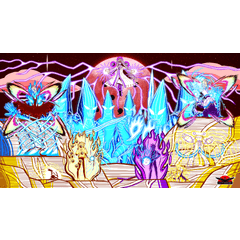How to shade based on a light source!
[1] About this Tutorial
When depicting anything with a drawing, shadows are unavoidable.
Have you ever felt like your illustration or manga is less than convincing?
If you have, the culprit may be your understanding(or lack thereof) of shading!
So today, we’ll cover “How to shade based on a light source”.
In the lesson, we’ll introduce the basics: shading a character, shading a sphere, etc.
[2] Understanding the basics of shading
First, I’ll explain the shadows on the surface of the basic shape: a sphere.
With an upper left light, light hits some parts directly, and other parts become dark, like the figure below.
This boundary between light and dark changes depending on the viewing angle and object.
As you can see below, with an upper left light, there are two types of shadows.
The shadow on the object itself, and the shadow cast by the object.
Also, the brightest point(where light hits at a right angle) becomes the highlight.
Even with this light’s angle, be careful not to forget the light reflecting off the floor. Keep in mind that parts hit by the reflected light won’t be brighter than parts where light hits directly.
[3] Shadows on a character’s face
Next, I’ll explain shadows formed near a character’s face and clavicle.
Same as the sphere, I’ll assume that the light source is on the upper left, and the shading will look like this.
Keep these four points in mind:
· Hair shadows
· Eye shadows
· Mouth shadows
· Clavicle shadows
We’ll start with the hair shadows. When hair bunches up and gains volume, shadows fall on the forehead like this.
Next are the shadows that fall on the eyes. Keep in mind that eyes are spheres.
As shown below, drawing the upper eyelid shadows with a curve adds three-dimensional depth to the eye.
When shading the mouth, be conscious of the back sections of the tongue and cheeks.
The think of the clavicle shadow as a triangle shape hollow.
The parts marked in red are the dents.
The actual drawn shadows are like this.
This concludes the shadows on the face and neck of the character. Shadows can be used to add three-dimensional depth to an object, so if you feel like the depth is off, checking your shading is a good idea.
[4] Shadows on a character’s body
Next is the shadows of the entire character. Let's see how shadows change along with a light source’s position using the illustration below.
■ Line Art
■ Upper and bottom light sources
Like so, an object has different shadows based on the light’s position. The same object can feel completely different based on the light source, so use light and shadow that best fit the situation.
On a related note, we cover shadows on hands and sleeves in Palmie's video course, so check them out if you want to know more about shading!
※ The video course is in Japanese.
[5] Palmie video course
The video also explains how to shade backlit subjects that we couldn’t cover in this course.
Please check it out if you want to know more about shading!
※ The video is in Japanese.
Over 100 free lessons are available on the drawing course website Palmie! Don’t miss the opportunity to check it out!
・Artist Profile: 60 mai
Hi, I’m 60 mai. I’ve been drawing digital illustration since 2007. I’m still learning myself, but I hope I can be of assistance.























Comment